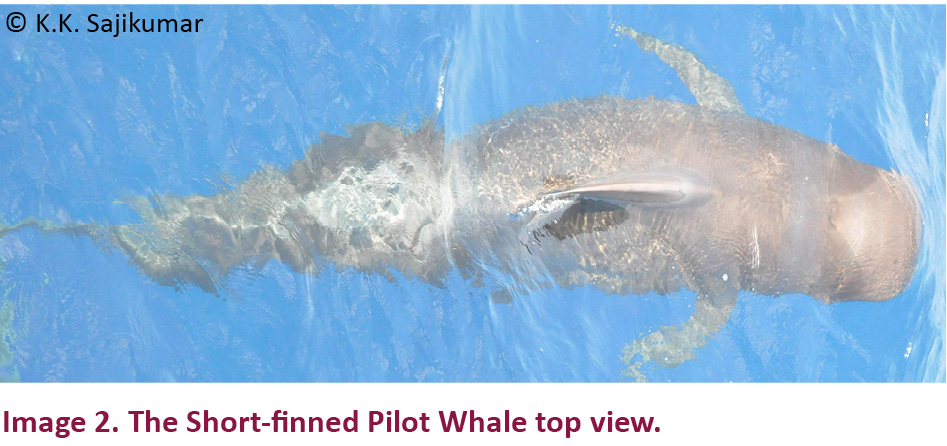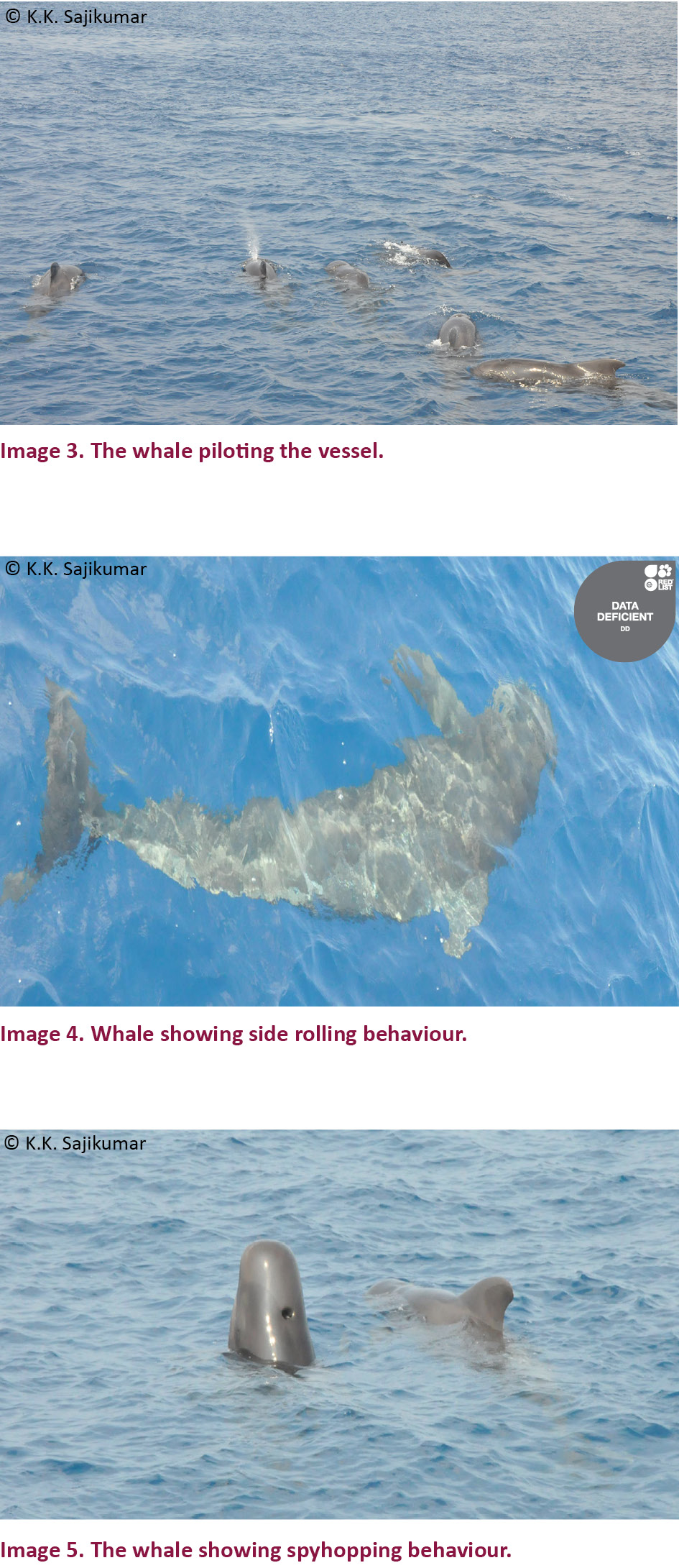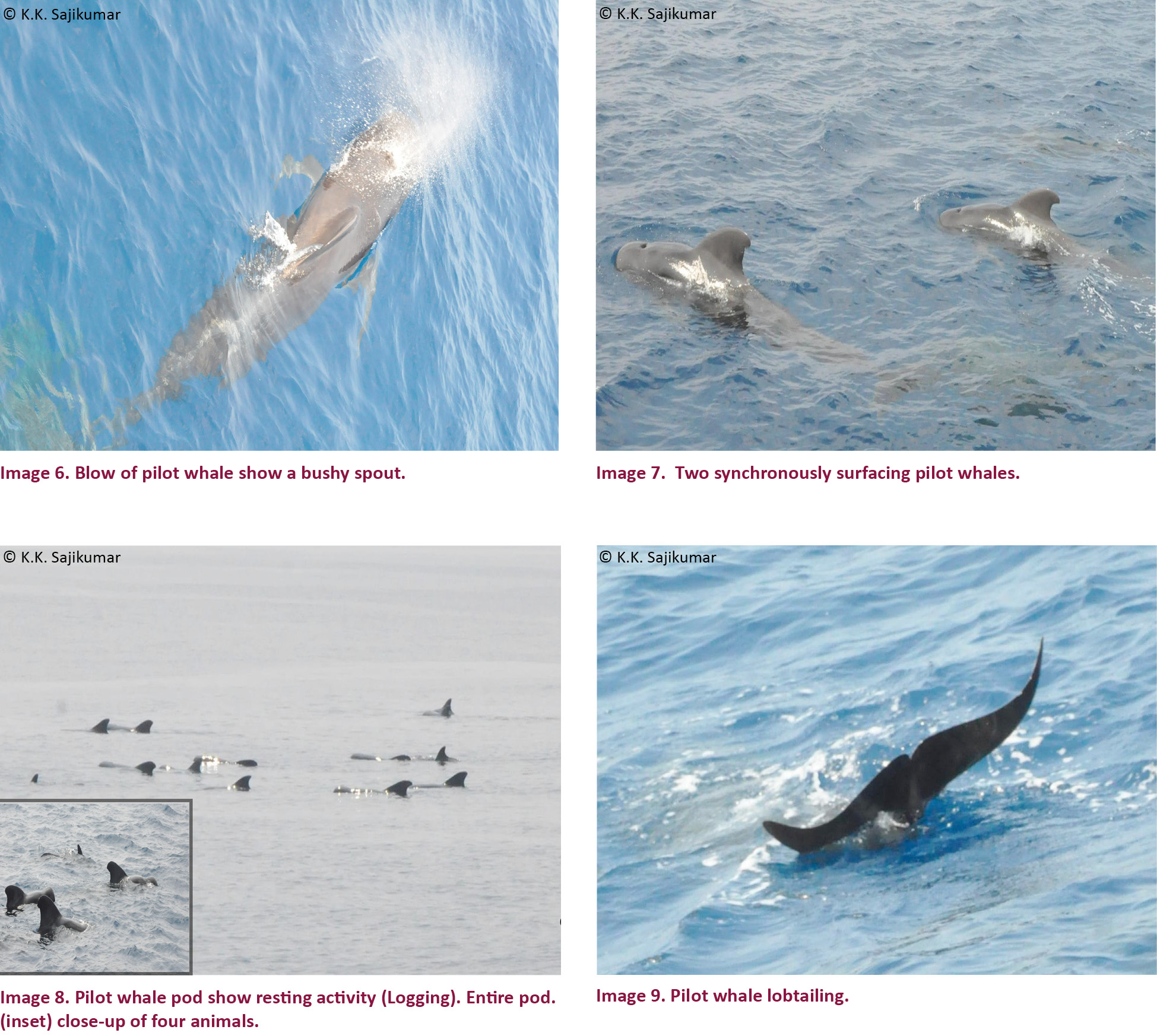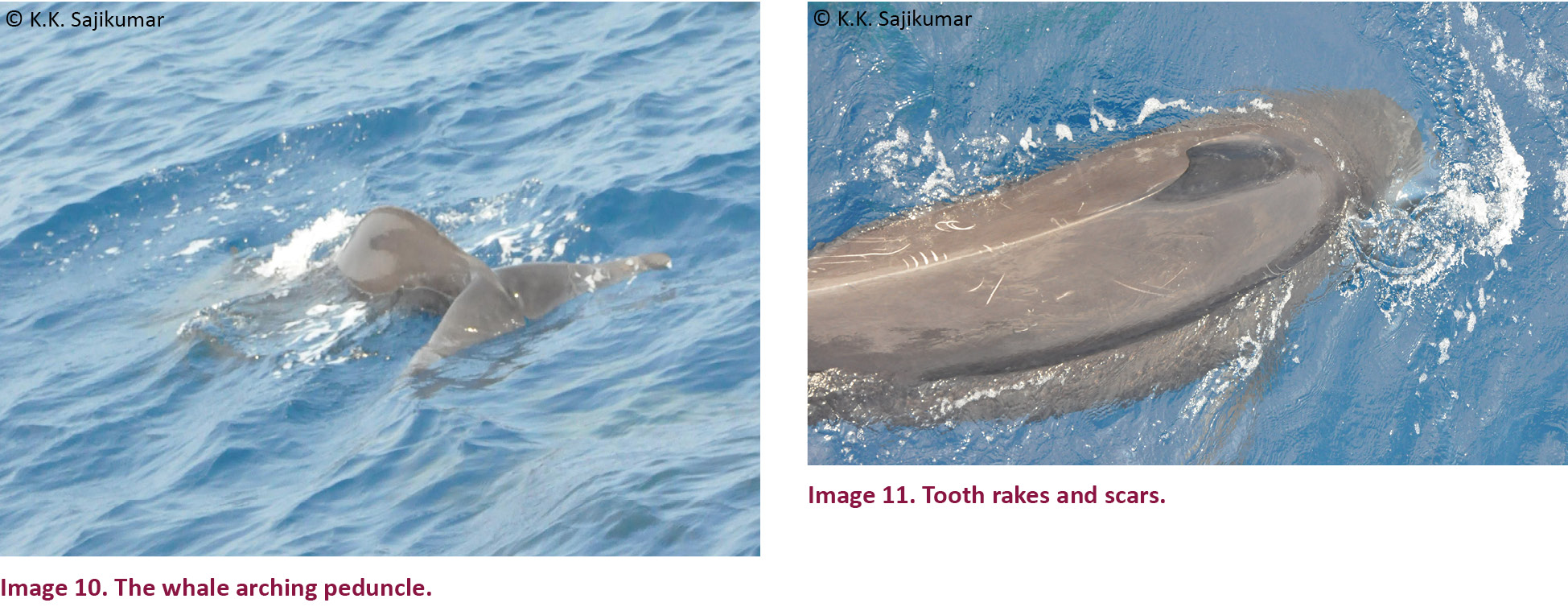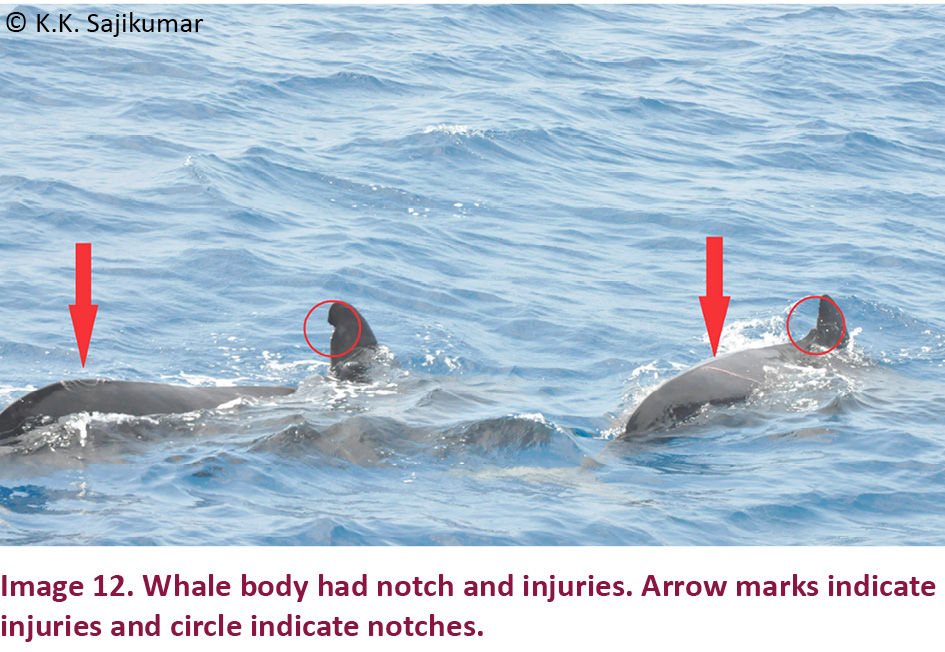doi: http://dx.doi.org/10.11609/JoTT.o3659.6488-92
Editor: Anonymity requested. Date of publication: 26 October 2014 (online & print)
Manuscript details: Ms # o3659 | Received 11 June 2013 | Final received 08 April 2014 | Finally accepted 06 October 2014
Citation: Sajikumar, K.K., N. Ragesh & K.S. Mohamed (2014). Behaviour of Short-finned Pilot Whales Globicephala macrorhynchus (Gray, 1846) (Mammalia: Cetartiodactyla: Delphinidae) in the southeastern Arabian Sea. Journal of Threatened Taxa 6(11): 6488–6492; http://dx.doi.org/10.11609/JoTT.o3659.6488-92
Copyright: © Sajikumar et al. 2014. Creative Commons Attribution 4.0 International License. JoTT allows unrestricted use of this article in any medium, reproduction and distribution by providing adequate credit to the authors and the source of publication.
Funding: Funding support from NAIP Scheme on Oceanic Squids (Code: 2000035101).
Competing Interest: The authors declare no competing interests.
Acknowledgements: This cruise was authorized by Central Marine Fisheries Research Institute (CMFRI), Kochi. The support from the crew of MFV Titanic and other colleagues is greatly appreciated. We also thank Mr. K.S. Abhilash and Dr. R. Jeyabaskaran of CMFRI, Kochi for their help in the identification.

The Short-finned Pilot Whale Globicephala macrorhynchus (Gray, 1846) are found in Indian waters including Lakshadweep and Andaman Islands (Vivekanandan & Jeyabaskaran 2012). They are large dolphins, and one of the largest members of the family Delphinidae. These dolphins were named “pilot whales” because it was believed that pods were “piloted” by a leader (Olson & Reilly 2009). They are typically found in deep water on the continental shelf and shelf break. Pilot whales are nomadic and their seasonal inshore/offshore movements are related to the distribution of squid, their favourite prey (Olson & Reilly 2009). Pilot whale stomachs contain mainly oceanic squid and small fish (Mintzer et al. 2008). Distribution and movements of Short-finned Pilot Whales are regulated by prey availability (Boris 2003). In 1982–83, a strong EI Niño event off the coast of southern California resulted in pilot whales avoiding the area presumably due to the absence of squid spawning (Jefferson et al. 2008).
They are highly social and usually found in pods of average 20–90 individuals (Olson & Reilly 2009). Short-finned Pilot Whales, among cetaceans, are species that most frequently mass-strand possibly due to their strong social bonds (Hohn et al. 2006). The IUCN lists this species as Data Deficient in the Red List of Threatened Species (Taylor et al. 2011). In India, most cetaceans are listed under Schedule 2 Part 2 of Wild Life (Protection) Act, 1972. Kumaran (2002, 2012) has reviewed the status of cetaceans and cetacean research in India. Mass strandings of Short-finned Pilot Whales have been reported along the southeastern coast of India (Alagarswami et al. 1973; Reghunathan et al. 2013) and sightings have been reported by Leatherwood & Donovan (1991) and Afsal et al. (2008). The behaviour of G. macrorhynchus has not been reported earlier from the Arabian Sea, and therefore, when an opportunistic sighting was made we recorded the behaviour of the pod.
Materials and Methods: The observations were made during routine squid jigging cruises of MFV Titanic in the month of February 2013. This cruise was conducted for exploration of the Purpleback Oceanic Flying Squid Sthenoteuthis oualaniensis popularly known as the Master of the Arabian Sea. The cruise track is shown in Image 1 and it covered the area west of Minicoy and Kalpeni Islands of Lakshadweep. Short-finned Pilot Whales were opportunistically sighted twice on 03 February 2013 at 1400hr and on 06 February 2013 at 0930hr. The surface water temperature at the location of sighting ranged from 28–30 0C and salinity between 32 and 34 ppt. On sighting the whales, the vessel approached as close to the pod as possible, cut the propellers and drifted alongside the pod for making observations. On 03 February 2013 the pod remained with the vessel for two hours and on 06 February 2013 it remained for four hours. The images of the animals were captured using a Nikon D90 camera fitted with 18–105 mm lens. The sighted animals were identified for species with the help of photographs. The species identification was confirmed with the aid of keys provided by Jefferson et al. (2008) and Vivekanandan & Jeyabaskaran (2012).
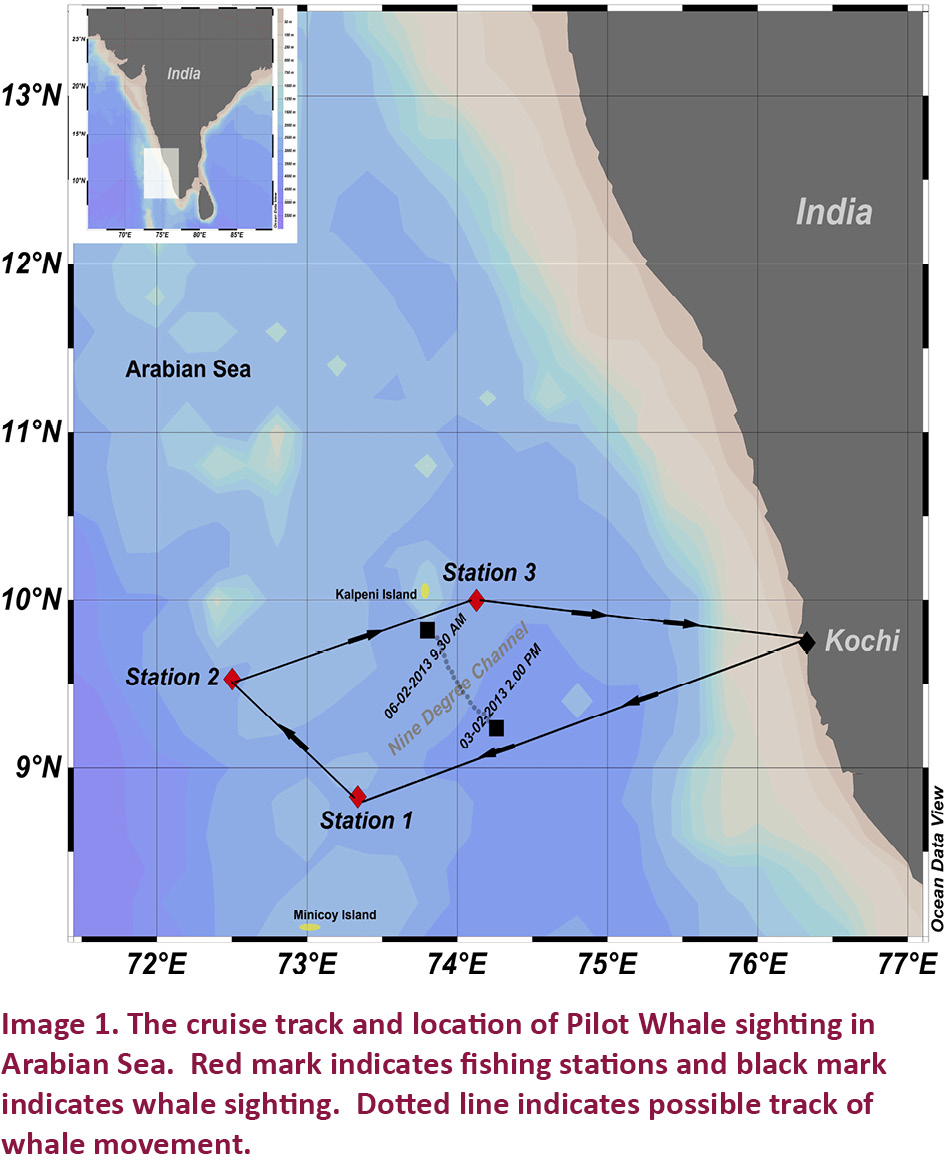
Results and Discussion: Short-finned Pilot Whales can be distinguished by its robust body with a thick tail stock. The melon is exaggerated and bulbous and beak is barely discernible or non-existent (Jefferson et al. 2008). The dorsal fin is wide, broad-based, falcate and set well forward on the body. The body colour of the species observed was dark brownish-grey (Image 2). This pod contained 12 animals of which four were males and eight were females. The males were identified by their massive, often lobed looking dorsal fin and female dorsal fin is pointy and less lobed than males (Jefferson et al. 2008).
During the first sighting off Minicoy Island, pilot whales were found to be associated with the Pantropical Spotted Dolphin Stenella attenuata. Pilot whales are commonly associated with other species such as Bottlenose Dolphins, Risso’s Dolphins and Sperm Whales (Jefferson et al. 2008). The pod size of observed Spotted Dolphins was around 30 and the pods were also associated with Yellowfin Tuna Thunnus albacares and they remained with the Short-finned Pilot Whales for two hours. The distance between the Short-finned Pilot Whales and dolphin pod was about 100m. Spotted Dolphins are commonly associated with Yellowfin Tuna, Spinner Dolphins, and other oceanic predators (Jefferson et al. 2008). The Yellowfin Tuna was identified when they leapt out of water, presumably chased by the whales and dolphins. The school size of Yellowfin Tuna was estimated to consist of 60 individuals of approximately 60cm average length and 4kg weight. Dolphins and Yellowfin Tuna were not seen during the second sighting.
We observed the Short-finned Pilot Whales showing a variety of interactive behaviours in close proximity to the vessel. The entire pod showed a tendency to move in front of the vessel akin to piloting the vessel (Image 3). Some whales showed interactive behaviour such as moving along with the vessel, rolling sideways (Image 4) below the surface and frequently crossing in front of the vessel.
Spyhopping: In spyhopping the whales hold their heads out of the water for visually inspecting above the water line (Image 5). Spyhopping of two whales close to the vessel was observed twice. They were able to keep their heads up for one minute at a time. Their eyes were just above the surface to see the water surface and surroundings. At the time of spyhopping, the whales hold their body vertical in the water (Hofmann et al. 2004).
Spouting: The present pod of pilot whales had a small bushy spout with a height of 40cm (Image 6). At the time of spouting a “pizzz” sound could be heard. They spout about 1–2 times per minute while travelling and the pod members move in the same direction at an average speed of 3knots. Spouting was not observed during resting.
Integrative behaviour: We also observed synchronous travelling and breathing, when two or more animals behave synchronously. Unless both were independently responding to some external stimulus, they were attempting to match each other’s behaviour, or at least one was trying to match the other’s behaviour synchronously and can, thus, be a particularly clear example of integrative behaviour (Whitehead 2008). A pair which was seen travelling side by side surfaced for breathing almost at the same time and in the same direction (Image 7). The spouting interval was no more than three seconds from one another. Such synchronization was observed during their respiratory behaviour and was not observed when resting (logging). Synchronous behaviour is thought to be a signal for cooperation or to reduce tension, sometimes seen as being involved with the advertisement or reinforcement of social bonds (Connor et al. 2006) which may be manifested more at times of stress (Hastie et al. 2003). This kind of behaviour gives an indication of the social structure of pilot whales.
Logging: The pod of pilot whales under observation exhibited resting activity too. While resting the whales came close to each other and appeared to be drifting. They simply floated on the surface and were inactive (Image 8). The dorsal fin and parts of the head were exposed and the entire pod behaved synchronously and this is called logging (Brownell et al. 2009). During resting the pod was very tightly packed and sometimes touched one another.
Lobtailing: We also observed whales lifting their flukes out of water and tail slapping while diving. This slapping motion makes a sound and is called lobtailing (Image 9). Flukes move up and down to force the speed and course. Tail slaps could also be a means of communication (Hofmann et al. 2004).
Peduncle arch: The whales also arched their caudal peduncle just before making a deep descent (Image 10). They were able to dive for 4–5 minutes.
Scarring and injuries: We observed different sized scars, tooth rakes and injuries on the bodies of some whales. Out of the 12 whales, four had scars. The scars were bright white in colour and irregular in size and shape. Some scars were seen on the dorsal side of the body and dorsal fin region. Tooth rakes were identified by the presence of more than two or more parallel lines. They were seen on two individuals just above the flippers and on the back of the dorsal fin and peduncle area (Image 11). A small notch was present the in dorsal fin trailing edge of three animals. The notch of fin edges is believed to result from injuries (Bigg et al. 1987). These marks are currently used for individual identification. Bigg (1982) confirmed the permanency of notches in whales by surgically removing two pieces from a Killer Whale’s dorsal fin. Injuries were observed on the dorsal surface of two whales which were approximately of 20 and 8 cm size respectively (Image 12). The large injuries were seen on the side of the peduncle area and the smaller one on the dorsal side of the head region. This may be due to intra-specific aggression, predator conflicts, finding and securing of food and anthropogenic activities like fishing gear entanglement, vessel collisions and propeller strikes (Auger-Méthé & Whitehead 2007).
Conclusion: This incidental sighting data indicates that this species is socially cohesive and show a variety of movement patterns and behaviour on the surface of the water. The pod was moving is a north-westerly direction in the Arabian Sea, probably in search of its favourite prey, the Purpleback Flying Squid. They also show interspecific association with Pantropical Spotted Dolphin Stenella attenuata. Out of the 12 whales observed, four had scars and injuries. We strongly recommend that more mammal targeted cruises are required in the Arabian Sea for obtaining more information about their distribution and behaviour.
